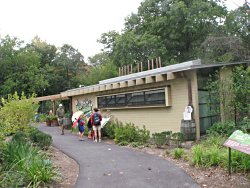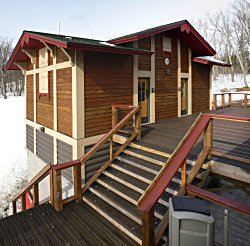American Institute of Architects National Convention and Design Exposition, Boston, MA
May 15-17, 2008
Clivus Presentation: Friday, May 16, 2008, 6:00-7:00 pm
National Association of State Park Directors Convention, Boise, ID
September 2-5, 2008
|
| eFact |
Less-Than-Refreshing
The EPA estimates that between 1.8 and 3.5 million US residents become sick every year from swimming waters contaminated by sanitary sewer overflows.
source: Natural Resources Defense Council, 2003 (From: www.ecocycle.org) |
| Also of Interest |
Sewage Sludge Victim Awarded Compensation
On March 6th, the Associated Press reported that a federal judge has ordered the Agriculture Department to compensate a Georgia farmer for the death of his cattle following the application of sewage sludge provided by Augusta’s sewage treatment facility. According to the article, “The sludge contained levels of arsenic, toxic heavy metals and PCBs two to 2,500 times federal health standards.” To read the full article, visit: www.abcnews.go.com
Kanawana Featured
Camp YMCA Kanawana’s new eco-friendly development is featured in the January/February issue of Camp Business. The new development, also discussed in the October 2007 issue of the Natural Solution News, includes new water and wastewater systems and two new bathroom facilities, which use 16 Clivus Multrum Composting Systems. To read the full article, visit: www.northstarpubs.com
Maintenance Services
Did you know that Clivus can arrange to provide your facility with composting system maintenance services? Clivus offers a variety of maintenance options to meet your needs. No matter where your facility is located, we’ll come to you or work with local subcontractors to ensure that the job is done right. Call us at 800-425-4887 for more information. |
|
Greetings from Clivus Multrum!
In this issue of the Natural Solution News, you’ll learn how Clivus Multrum has helped the Bronx Zoo extend its mission of conservation into its new Eco-Restroom. You’ll also learn how Clivus has helped the Midwest’s biggest ski resort, Lutsen Mountains, meet its expansion goals while protecting and conserving local water resources.
Also, if you’re in Boston for the 2008 AIA National Convention, please attend our presentation, “Up the Creek: How We Got Hooked on Sewage and How We Can Break the Habit” on Friday, May 16, from 6:00—7:00 p.m.
Bronx Zoo: Ahead of the Herd
 |
| The Bronx Zoo Eco-Restroom serves over 500,000 visitors annually. |
The Bronx Zoo knows conservation. Since it opened its gates to the public in 1899, the Zoo, under the direction of its parent organization, the Wildlife Conservation Society (WCS), has continually worked to fulfill its mission “to advance the study of zoology, protect wildlife, and educate the public.” More recently, the Bronx Zoo has expanded its mission of conservation and education to include its facilities.
In the fall of 2006, the Zoo finished work on its new Eco-Restroom at the Bronxdale Gate entrance, which was designed to accommodate more than ½ million visitors annually. The Eco-Restroom replaces an older restroom building which, according to Jon Dohlin, the Zoo’s former Project Manager for Capital Construction, had fallen into disrepair and had been closed due to concern over its failing septic system’s potential to pollute the Bronx River.
| According to the environmental group Riverkeeper, “More than 27 billion gallons of raw sewage and polluted stormwater discharge out of 460 combined sewage overflows (“CSOs”) into New York Harbor each year...” |
WCS and the design team decided the new restroom should be an example of how to manage human waste sustainably, conserve resources, and prevent pollution. It was determined that key to reaching these aims was to use composting toilets and greywater irrigation systems for the project. This means that the Eco-Restroom is not connected to the City’s sewer system. Instead, toilet waste is collected in the compost system and water from sinks and drinking fountains (greywater) is used to irrigate plants outside the structure. The resulting model of sustainability sharply contrasts with the problems associated with big city sewage treatment systems, such as New York’s.
According to the environmental group Riverkeeper, “More than 27 billion gallons of raw sewage and polluted stormwater discharge out of 460 combined sewage overflows (“CSOs”) into New York Harbor each year,” from the Bronx and from locations throughout the city. The problem of sewage treatment plant capacity encouraged the New York City DEP, which manages New York’s sewage treatment plants, to fund the purchase of the Eco-Restroom’s composting toilets and greywater system.
The Eco-Restroom’s Clivus Multrum Compost Toilet Systems include 14 foam-flush toilet fixtures, 4 waterless urinals, and 10 composters—which are maintained by the manufacturer. The foam-flush fixtures use just 3-6 ounces of water and a drop of soap to flush waste down a conventional drainpipe to the composters below. In the composter, solid and liquid wastes are separated and transformed, through natural biological decomposition, into a topsoil-like compost and a potent liquid fertilizer. In total, these systems have the potential to save over 1,000,000 gallons of water per year, as compared to conventional low-flow toilets.
The Clivus Multrum Greywater Irrigation System collects water from the restroom’s non-toilet fixtures in a small tank in the basement and sends it into an 80’x 20’ flower garden. The greywater is distributed through buried half-round pipes into the garden’s root zone, where plants use the water and the small amount of nutrients contained in the water from soap. Because greywater is used for plant irrigation and toilet wastes are contained in the composters, there is no pollution discharge, as is the case with buildings attached to sewers or septic systems.
Recently named Eco Project of the Year by New York Construction, the Eco-Restroom uses a number of other green building technologies in addition to compost toilets and greywater systems, including a rainwater harvesting system, natural daylighting, high-efficiency light bulbs, and a highly efficient radiant floor heating system. The Eco-Restroom, though, is not a one-off example of green-building at the Zoo. Dohlin says the Zoo is currently at work on two more eco-friendly buildings—both of which are being built to achieve LEED certification. The new Lion House building will go for LEED Gold and the Center for Global Conservation, which will house the WCS international department and function as a conference center, will go for Silver. Such commitment as shown by the WCS to sustainable building practice demonstrates its concern not just for wildlife but for the entire animal kingdom.
Resort Achieves Peak Efficiency in New Facilities
 |
| Lutsen's Moose Mountain peak restrooms include four Clivus Multrum composters.* |
Overlooking Lake Superior in northeastern Minnesota, Lutsen Mountains Ski Resort is the Midwest’s largest ski area. Lutsen first offered skiing in 1948. Back then, Lutsen had only one lift, and skiers had just two trails to choose from. Lutsen added chairlifts and snowmaking in the sixties, and the resort now includes four peaks: Moose Mountain, Eagle Mountain, Ullr Mountain, and Mystery Mountain. The four peaks include a total of 1000 skiable acres, 9 lifts, and 90 trails, and attract approximately 100,000 skiers and snowboarders each winter.
Of the 100,000 skiers and snowboarders that visit Lutsen Mountains annually, roughly 70,000 ski and ride on Moose Mountain. In order to serve the hordes of skiers and snowboarders, Lutsen drafted plans to expand and enhance its Moose Mountain peak dining and restroom facilities in 2004. However, the expansion was not without its challenges. Because the location lacks access to the sewer, the design team needed to consider how it would manage an increased volume of waste using onsite systems.
| Because the six Clivus Multrum toilet fixtures and two Clivus urinals in the Moose Mountain restrooms use no water for flushing, expanding the existing septic system was unnecessary. |
Initially, Lutsen co-owner Tom Rider and the team considered expanding the existing septic system to accommodate flush toilets and hand washing sinks in the new restroom. However, the site’s water supply was limited, and its soil consisted mainly of bedrock. Due to the soil’s impermeability, flush toilets would have required a new septic system with a large leach field. Because this would have infringed on the space needed for new facilities, the design team looked elsewhere for a water-conserving technology that would prevent the need for a new septic system while still providing guests with the level of comfort they expected.
The owners solved the problem by purchasing waterless composting toilet systems for the new restrooms in the summer of 2005. Because the six Clivus Multrum toilet fixtures and two Clivus urinals in the Moose Mountain restrooms use no water for flushing, expanding the existing septic system was unnecessary. Instead, four medium-sized Clivus composting units below the restrooms separate and treat urine and feces and yield high-quality fertilizer end-products. The systems handle up to 180,000 uses annually. This amounts to an annual water savings of up to 280,000 gallons, as compared to conventional 1.6 gpf toilets.
After two years in use, Lutsen Mountains co-owner Tom Rider is very pleased with the technology. Rider says the Clivus systems require little maintenance and adds, “I’m not aware of a single complaint.” And although no compost has been removed so far, Rider plans to use it as a soil amendment on the mountain. For now, visitors who lighten their load in the Moose Mountain restrooms can be happy knowing that their contributions will eventually help make the Midwest’s biggest ski area just a bit greener.
*Photo courtesy of Mark Tessier, Lutsen Mountains Ski Resort |
